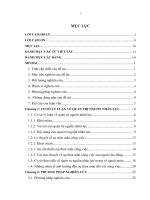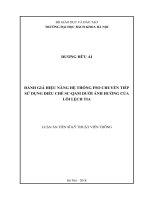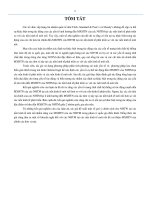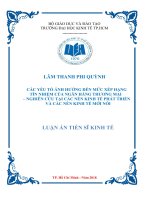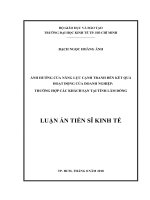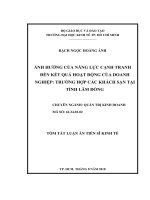ẢNH HƯỞNG TÍCH LŨY dự TRỮ NGOẠI hối đến LẠM PHÁT VÀ HOẠT ĐỘNG CAN THIỆP TRTOM TAT LUAN AN tieng anh
Bạn đang xem bản rút gọn của tài liệu. Xem và tải ngay bản đầy đủ của tài liệu tại đây (760.8 KB, 24 trang )
1
MINISTRY OF EDUCATION AND TRAINING
STATE BANK OF VIETNAM
BANKING UNIVERSITY HO CHI MINH CITY
NGUYEN THI KIM PHUNG
THE IMPACT OF FOREIGN RESERVES ACCUMULATION ON INFLATION
AND STERILIZATION OF THE STATE BANK OF VIET NAM
SUMMARY OF PHD THESIS
Major
: Finance - Banking
Code : 9.34.02.01
Candidate
: NGUYEN THI KIM PHUNG
Course: 20
Scientific Supervisors:
Ass. Prof HOANG THI THANH HANG
Ass. Prof VO XUAN VINH
HO CHI MINH CITY – 2018
2
CHAPTER 1
INTRODUCTION OF THE RESEARCH
1.1.
Background and Statement of the Research
Financial globalization and the expansion of international capital flows have
benefited nations. But these also increase the risk of financial crisis. Developing countries
have accumulated a considerable amount of foreign reserves to deal with a series of financial
crises in the world. In addition to the role of financial stability, foreign reserves can have
direct or indirect impact on the macroeconomic through various aspects (Drummond et al,
2009; Hviding et al, 2004; etc.). However, the foreign reserves accumulation increases the
base money and the expansion of money supply if central bank doesn’t sterilize conducive
to inflation. Sterilization occurs when the central bank performs simultaneous transactions
on foreign assets and domestic assets to neutralize the effects of foreign exchange market
intervention on domestic money supply.
In the trend of international economic integration, in recent years, foreign reserves of
Vietnam have increased, and the tendency of accumulation foreign reserves in Vietnam is
necessary next time. Vietnam is in the process of deep integration in finance and other fields,
changes in macroeconomic policies and economic environment continue to cause difficulties
and challenge for policy managers. Clear understanding of the spread effects of
accumulating foreign reserves on inflation as well as sterilization contribute significantly to
the policy management of the State Bank of Vietnam (SBV), help to the success and
sustainability of the economy.
The above information are the practical meanings of the research. In theory, the thesis
is studied on the basis of exploring the gaps that previous studies is not mention.
There are many papers analyzing relationship between foreign reserve accumulation
and inflation for different countries and group of countries, such as Heller (1979), Khan
(1979), Lin &Wang (2005), Elhiraika & Ndikumana (2007), Steiner (2009), Borivoje &
3
Tina (2015), Chaudhry et al (2011), Chen & Huang (2012), Zhou et al (2013), Pham Thi
Tuyet Trinh (2015), etc. However, no papers have investigated the characteristics of each
country's economy, which characterizes the Vietnamese economy as a dollarized economy.
Therefore, this study focuses on assessing the impact of accumulating reserves on inflation
in a dollarized economy.
In terms of sterilization, there have been some studies on the effectiveness of central
bank intervention in some countries, mainly in emerging markets such as Latin America
countries (Aizenman & Glick, 2009; Ljubaj et al, 2010) and Asian countries (Glick &
Hutchison, 2009; Ouyang et al, 2010 ; Wang, 2010 ; He et al,2005; Takagi & Esaka, 2001;
Cavoli & Rajan, 2006). In Vietnam, there are studies by Pham Thi Tuyet Trinh and Nguyen
Thi Hong Vinh (2011), Pham Thi Hoang Anh and Bui Duy Phu (2013), Dang Van Dan
(2015) with the results show that the SBV's sterilization has not been effective in the past.
However, in the above studies, no studies have evaluated the sterilization’s effectiveness in
the context of dollarized economies. The thesis will focus on the sterilization’s effectiveness
of the SBV in the context of a dollarized economy. In addition, during the study period, the
global financial crisis occurs in 2007 and 2008, so the thesis also considers whether the
global financial crisis has an impact on the effectiveness of the SBV's sterilization.
From the practical and theoretical point of view, the topic "The impact of foreign reserves
accumulation on inflation and sterilization of the State Bank of Vietnam" has been
chosen.
1.2. Objectives of the study
1.2.1. General objective of the study
The dissertation examines the influence of foreign reserves accumulation on inflation
and sterilization of the SBV to ensure the stabilization of monetary policy for social and
economic development.
1.2.2. Specific objectives of the study
From the general objective, the thesis aims to achieve the following specific objectives:
4
First, assessing the current status of foreing exchange reserves, dollarization and
tools of the sterilization in Vietnam.
Second,evaluating the short-term and long-term effects of accumulating foreign
reserves on inflation in Vietnam in the context of a dollarized economy.
Third, examining the effectiveness of the neutral intervention of the SBV in the
context of a dollarized economy and studying the impact of the two factors : dollarization
and global financial crisis on the sterilization’s effectiveness of the SBV.
Finally, exploring the experience of sterilization in some countries around the world
to provide experience lessons for Vietnam.
1.3. Research questions
From the above specific objectives, the research questions are as follows:
+ How is the current status of foreing exchange reserves, dollarization and tools of the
sterilization in Vietnam ?
+ How does accumulation of foreign reserves in short-term and long-term impact on
inflation in Vietnam in the context of dollarized economy?
+ How is the sterilization’s effectiveness of the SBV in the context of the dollarized
economy
+ Do dollarization and the global financial crisis change the level of SBV sterilization’s
effectiveness?
+ How is the experience of sterilization in terms of tools, effectiveness, sustainability and
financial costs in some countries around the world and what are lessons for Vietnam?
1.4. Research subjects and scopes of the study
- The research subjects are the effect of accumulation of foreign reserves on inflation and
the sterilization of the SBV.
- The scopes of the study:
+Space: The thesis examines the impact of foreign exchange reserves on inflation and
sterilization in Vietnam.
5
+Time: Thesis studies in Vietnam from the first quarter of 2004 to the second quarter of
2017
1.5. Research methodology
The thesis uses quantitative research method (ARDL Bound Test Model and 2SLS
Estimation) in combination with synthesis, analysis, comparison and case study.
1.6. Contributions of the thesis
The dissertation provides a comprehensive theoretical basis for the mechanism of
impact of accumulating foreign exchange reserve effects on inflation and sterilization. The
thesis first time examines these issues in the context of a dollarized economy. Moreover, the
study first time analysis in deep whether dollarization and global financial crisis change the
sterilization’s effectiveness in Vietnam.
The dissertation proposes some policy recommendations and experience lessons for
the SBV to neutralize unwanted effects on the economy as the SBV accumulates foreign
exchange reserves.
1.7. Structure of the thesis
The dissertation consists of five chapters:
Chapter 1: Introduction of the research
Chapter 2: Theoretical background and empirical evidence on the impact of foreign
reserves accumulation on inflation and sterilization of the central bank.
Chapter 3: Research methodology and data.
Chapter 4: Research Results and Discussion
Chapter 5: Conclusions and policy implications
6
CHAPTER 2
THEORETICAL BACKGROUND AND EMPIRICAL EVIDENCE ON
THE IMPACT OF FOREIGN RESERVES ACCUMULATION ON
INFLATION AND STERILIZATION OF THE CENTRAL BANK
2.1. Some concepts
Accumulation of foreign reserves
Foreign reserves are those external assets that are readily available to and controlled by
monetary authorities for meeting balance of payments financing needs, for intervention in
exchange markets to affect the currency exchange rate, and for other related purposes such
as maintaining confidence in the currency and the economy, and serving as a basis for
foreign borrowing (IMF, 2009).
Accumulation of a country's foreign reserves is an activity which gradually increases
the country's foreign exchange reserves through a period of time. Inside, foreign reserves
are foreign assets that are available and controlled by the monetary authority of the country
in order to meet the balance of payments requirements, to intervene in the foreign exchange
market for impacting exchange rates and other related purposes.
Sterilization of central bank
According to Krugman et al (2012), sterilization occurs when the central bank
performs simultaneous transactions on foreign assets and domestic assets for neutralizing
the impact of central bank interventions in foreign markets on the domestic money supply.
7
2.2. Mechanism of the impact of foreign reserves accumulation on inflation and
sterilization of the central bank
2.2.1. Mechanism of the impact of foreign reserves accumulation on inflation
The mechanism of impact of foreign reserves on inflation through monetary channel
Accumulation of foreign exchange reserves affects inflation through the following
mechanisms:
The increase in foreign reserves led to a change in the money supply of a country,
and the increase in money supply affected the country's inflation. This mechanism is
explained in two phases:
(i) Impact of accumulating foreign reserves on money supply
(ii) Impact of money supply on inflation.
In closing, the impact of foreign reserves on inflation can be summarized in the
following diagram:
Foreign reserves Money Base Money Supply Inflation
The mechanism of impact of foreign reserves on inflation through channels of
receiving allocated SDRs by IMF
Receiving allocated SDR does not cause inflation but the use of SDR can lead to inflation.
With increased international liquidity due to loosening foreign reserve limits, countries that
receive allocated SDRs will pursue broader monetary policy. This in turn affects the money
supply and causes inflation as above mechanism.
2.2.2. The mechanism of sterilization
Sterilization in the narrow sense
Sterilization in the narrow sense reflects interventions by central banks to reduce the money
base in the economy as the central bank purchases foreign currency in the foreign exchange
market. When the central bank purchases foreign currency in the foreign exchange market
without a neutral intervention, this result will increase Net Foreign Assets (NFA) and Base
Money (MB). If the central bank sterilizes, instead of increasing MB, the Net Domestic
8
Assets (NDA) will decrease to the right amount by an increase in MB if there is no
sterilization.
Sterilization in the broad sense
Sterilization in the broad sense reflects the central bank's intervention to reduce the money
supply in the economy as the central bank purchases foreign currency in the foreign
exchange market. In order to preform this matter, the central bank will use measures to affect
the money multiplier to reduce the ability to make money of commercial banks.
2.3. Empirical evidences
2.3.1. Empirical studies of the impact of foreign reserves accumulation on inflation
The previous papers estimate the effect of foreign reserves accumulation on inflation in two
ways: though monetary channel and though receiving allocated SDRs by IMF channel.
According to the monetary channel, the empirical studies approaches in three way:
worldwide, group of countries and different countries.
+The studies analyzing in the worldwide include: Heller (1979), Khan (1979), Rabin
& Pratt (1981), Heller (1981), Steiner (2009), Steiner (2017).
+The studies analyzing group of countries include: Lin & Wang (2005), Elhiraika &
Ndikumana (2007), Borivoje & Tina (2015)
+ The studies analyzing different countries include: Chaudhry et al (2011), Chen &
Huang (2012), Zhou et al (2013), Pham Thi Tuyet Trinh (2015).
According to the receiving allocated SDRs by IMF channel, there are two
representative papers: Neumamn (1973) and Chitu (2016).
2.3.2. Empirical studies of the efficiency of central banks sterilization
The empirical studies of the efficiency of central banks sterilization in the world are
divided into two main approaches.
The first approach primarily examines the relationship between the NDA and the
NFA in the monetary policy reaction function with two main estimation methods, the
Ordinary Least Square method and the Vector Auto Regression model, includes the papers:
Moreno (1996), Takagi & Esaka (2001), Cavoli & Rajan (2006), Aizenman & Glick (2009),
9
Glick & Hutchison (2009), Pham Thi Tuyet Trinh & Nguyen Thi Hong Vinh (2011), Dang
Van Dan (2015), He et al (2005).
The second approach used simultaneous equations to examine the relationship
between NDA and NFA and applies the Two Stage Least Squares (Or Three Stage Least
Squares if needing to fix autocorrelation between residuals), includes the papers: Brissimis
et al (2002), Ouyang et al (2010), Wang (2010), Ljubaj et al (2010), Ouyang & Rajan (2011).
2.4. The research gaps
2.4.1. The research gap of the impact of foreign exchange reserve on inflation
In Vietnam, the effect of accumulating foreign reserves on inflation through using
SDRs channel can be considered as insignificant, so this channel is ignored and the thesis
only analyzes the relationship between foreign reserves accumulation and inflation through
monetary channel. According to the monetary channel, there are many studies established a
research equation by examining the direct relationship between foreign reserves and
inflation, or through the intermediate variable, money supply, such as Heller (1979), Khan
(1979), Rabin & Pratt ( 1981), Abdullateef & Waheed (2010), Chaudhry et al (2011), Zhou
et al (2013). Therefore, they do not clearly reflect the relationship between accumulation of
foreign reserves and inflation. In addition, there is no study evaluating the effect of foreign
reserves accumulation on inflation that examines the characteristics of the dollarized
economy. So that, the thesis will focus on clarifying this problem.
2.4.2. The research gap of effectiveness of central bank’s sterilization
In general, all previous studies aimed to estimate the sterilization coefficient and the
offset coefficient to evaluate the effectiveness of central bank’s sterilization. But in the
previous studies, there has been no study assessing the effectiveness of sterilization in the
context of dollarized economy. In addition, the global financial crisis has had a significant
impact on the performance of central banks and has not been mentioned in previous studies.
Thus, the thesis will assess the impact of dollarization and the global financial crisis on the
effectiveness of the SBV’s sterilization.
10
CHAPTER 3
RESEARCH METHODOLOGY AND DATA
3.1. Conceptual model
3.1.1. Conceptual model of impact of foreign reserves on inflation
The model was originally derived from Steiner (2009). In addition, to consider the effect
of accumulating foreign reserves on inflation in the context of a dollarized economy, the
authors adds dollarization to the research model. Conceptual model is as follows:
P = f (NFA, NDA, mm, V, Y, DL) (3.1)
Where mm is the money multiplier; V is the velocity of money; DL is the rate of dollarization of
the economy and Y is aggregate output.
3.1.2. Conceptual model of effectiveness of the SBV’s sterilization
Based on the study by Brisimiss & ctg (2002), Ouyang & Rajan (2011) and combined
with an analysis of the dollarized economy, the thesis uses the following simultaneous
equations:
NDA*t = 0 +1NFA*t + 2Dmmt +3DCPIt-1 + 4 Yt-1 + 5CAt-1 + 6(r*t+ Etet+1)
+ 7DDLt-1+8KH +9(d1-1) r,t-1+ 10ut (3.6)
NFA*t = 0 +1NDA*t+ 2mmt +3CPIt-1+ 4Yt-1+ 5CAt-1 + 6(r*t+ Etet+1) +
7DLt-1+ 8KH + 9(d2-1) e,t-1 + 10vt (3.7)
Where: CPI is the inflation; CA is the current account; r* + Ee is the foreign interest
rate plus the expected nominal exchange rate; r is the interest rate volatility; e is the
exchange rate volatility and KH is the financial crisis
3.2. Estimation method
3.2.1. Estimation method of the model which evaluates the impact of accumulating
foreign reserves on inflation
The study us��������������������������������������������������������������������������������������������������������������������������������������������������������������������������������������������������������������������������������������������������������������������������������������������������������������������������������������������������������������������������������������������������������������������������������������������������������������������������������������������������������������������������������������������������������������������������������������������������������������������������������������������������������������������������������������������������������������������������������������������������������������������������������������������������������������������������������������������������������������������������������������������������������������������������������������������������������������������������������������������������������������������������������������������������������������������������������������������������������������������������������������������������������������������������������������������������������������������������������������������������������������������������������������������������������������������������������������������������������������������������������������������������������������������������������������������������������������������������������������������������������������������������������������������������������������������������������������������������������������������������������������������������������������������������������������������������������������������������������������������������������������������������������������������������������������������������������������������������������������������������������������������������������������������������������������������������������������������������������������������������������������������������������������������������������������������������������������������������������������������������������������������������������������������������������������������������������������������������������������������������������������������������������������������������������������������������������������������������������������������������������������������������������������������������������������������������������������������������������������������������������������������������������������������������������������������������������������������������������������������������������������������������������������������������������������������������������������������������������������������������������������������������������������������������������������������������������������������������������������������������������������������������������������������������������������������������������������������������������������������������������������������������������������������������������������������������������������������������������������������������������������������������������������������������������������������������������������������������������������������������������������������������������������������������������������������������������������������������������������������������������������������������������������������������������������������������������������������������������������������������������������������������������������������������������������������������������������������������������������������������������������������������������������������������������������������������������������������������������������������������������������������������������������������������������������������������������������������������������������������������������������������������������������������������������������������������������������������������������������������������������������������������������������������������������������������������������������������������������������������������������������������������������������������������������������������������������������������������������������������������������������������������������������������������������������������������������������������������������������������������������������������������������������������������������������������������������������������������������������������������������������������������������������������������������������������������������������������������������������������������������������������������������������������������������������������������������������������������������������������������������������������������������������������������������������������������������������������������������������������������������������������������������������������������������������������������������������������������������������������������������������������������������������������������������������������������������������������������������������������������������������������������������������������������������������������������������������������������������������������������������������������������������������������������������������������������������������������������������������������������������������������������������������������������������������������������������������������������������������������������������������������������������������������������������������������������������������������������������������������������������������������������������������������������������������������������������������������������������������������������������������������������������������������������������������������������������������������������������������������������������������������������������������������������������������������������������������������������������������������������������������������������������������������������������������������������������������������������������������������������������������������������������������������������������������������������������������������������������������������������������������������������������������������������������������������������������������������������������������������������������������������������������������������������������������������������������������������������������������������������������������������������������������������������������������������������������������������������������������������������������������������������������������������������������������������������������������������������������������������������������������������������������������������������������������������������������������������������������������������������������������������������������������������������������������������������������������������������������������������������������������������������������������������������������������������������������������������������������������������������������������������������������������������������������������������������������������������������������������������������������������������������������������������������������������������������������������������������������������������������������������������������������������������������������������������������������������������������������������������������������������������������������������������������������������������������������������������������������������������������������������������������������������������������������������������������������������������������������������������������������������������������������������������������������������������������������������������������������������������������������������������������������������������������������������������������������������������������������������������������������������������������������������������������������������������������������������������������������������������������������������������������������������������������������������������������������������������������������������������������������������������������������������������������������������������������������������������������������������������������������������������������������������������������������������������������������������������������������������������������������������������������������gh the scale of foreign reserves in Vietnam is not
seriously warned but it is still quite low.
4.1.2. The status of dollarization in Vietnam
The rate of dollarization has been continuously decreasing since 2004. According to
the IMF, a highly dollarized economy when the ratio of foreign currency deposits and total
means of payment is over 30%. Thus, during the study period, the rate of dollarization in
Vietnam is not as high as the IMF warning, always below 25% and improved gradually.
4.1.3. The status of sterilizing instruments used in Vietnam
The SBV mainly sterilizes the money base when intervening in the foreign exchange
market using the Open market Operation (OMO). Over time, OMO has gradually been used
by the SBV to regulate the monetary market. It helps the SBV stabilizes the money supply
and controls inflation. During the period both against inflation and sterilization (2007 and
2008), reserves requirement and other instruments such as refinance rate, rediscount rate,
government deposit have the effect of being sterilization instruments. However, these
instruments are not used in time to sterilize, they just are used to implement national
monetary policy.
17
4.2. Research results
4.2.1. Research results of the impact of foreign reserves accumulation on inflation in
Vietnam
After satisfying the diagnostic testing conditions of the ARDL Bound Test model,
the results of long-term impact are shown as follows:
Table 4.13. Estimated long run coefficients and speed of adjustment coefficient
Variable
Coefficient
Standard
Error
t statistic
Prob.
NFAt*
0.38 (***)
0.11
3.23
0.0031
NDAt*
0.54(***)
0.15
3.43
0.0019
mmt
0.20(***)
0.02
7.11
0.0000
Yt
0.02(**)
0.00
2.15
0.0396
Vt
0.40(***)
0.12
3.33
0.0024
DLt
-0.38(***)
0.05
-7.18
0.0000
ECt-1
-0.28 (***)
0.02
-10.25
0.0000
Sources: Author’s calculation
In addition, to evaluate the short-term effects of accumulation of foreign reserves and
dollarization to inflation, the author continues to test the Wald Test of the coefficients of
NFA *t and DL variables in the difference equation (3.8). The estimation results are as
follows:
Table 4.14. Wald test results for ECM equations
Wald Test
Variable
t- statistic
Prob
NFA*
5.49
0.000
DL
8.08
0.000
Sources: Author’s calculation
18
Thus, the results show that the null hypothesis H0, the coefficients of the variables
NFA * and DL in the difference equation (3.8) are zero, are rejected. This shows that the
coefficients are non-zero. Therefore, in the short run, both NFA *t and DL have an impact
on CPI.
4.2.2. Research results of the effectiveness of the SBV’s sterilization
The estimation results of the sterilization coefficient and offset coefficient are
shown in Table 4.19
Table 4.19. The estimation results of the sterilization coefficient and offset coefficient
Variable
Equation (3.6)
Equation (3.7)
NDA*t
-
NFA*t
-0.680***(0.149)
MMt
-0.395***(0.045)
-0.372***(0.037)
CPIt-1
-0.064(0.153)
-0.161(0.118)
Yt-1
-0.245(0.332)
-0.386(0.261)
CAt-1
-0.046(0.073)
0.098**(0.032)
(r*t+Eet+1)
0.034(0.147)
0.172(0.123)
DLt-1
-0.015(0.059)
-0.145**(0.067)
KH
0.046(0.283)
0.527***(0.135)
(d1-1)r,t-1
-0.231*(0.132)
-0.880***(0.122)
-
(d2-1)e,t-1
-
-0.818(0.518)
AR(1)
-
-0.305***(0.114)
R2
0.920
0.933
SE
0.023
0.023
Correlation LM Test ( P_ value )
0.714
0.172
Heteroskedasticity Test: ( P _ value )
0.119
0.98
ADF Test of residual
-7.808***
-7.24(***)
Note: (***): Significance at 1%; (**) : Significance at 5% ; (*) : Significance at 10%
Data in parentheses () is standard error
19
Sources: Author’s calculation
In order to evaluate whether dollarization changes the effectiveness of the SBV's
sterilization through offset coefficient, the authors continue to perform tests in Equation
(3.7) with the interactive variable DDLt-1 * DNDA. The results showed that DDLt-1 *
DNDA was not statistically significant (P value = 0.4135). Although dollarization has an
impact on the NFA, dollarization has not changed the level of NDA impact on the NFA.
Thus, dollarization does not directly affect the offset coefficient. Continuing the same test
for KH, the results are as follows
Table 4.20. The result of estimating the coefficient of offset with interactive variable
Variable
Coefficient
Standard Error
NDA*t
- 0.733 ***
0.148
KH
0.311**
0.011
KH*NDA*t
-0.343**
0.138
Note: (***): Significance at 1%; (**): Significance at 5%; (*): Significance at 10%
Sources: Author’s calculation
Thus, estimation coefficients are statistically significant. The author continues to
perform Wald Test with KH variable and interactive variable KH*NDA*t. The result shows
that the null hypothesis (these coefficients are zero) is rejected (P value = 0.0001). This mean
that there is a difference in NFA variability in crisis condition and in no crisis condition.
The results of rolling estimation of sterilization coefficient and offset coefficient are
shown in figure 4.22
20
-0.4
-0.5
-0.5
-0.6
-0.7
-0.6
-0.8
-0.7
-0.9
-0.8
-1
-0.9
-1.1
Hệ số can thiệp trung hòa
+2se
-2se
Hệ số bù đắp
+2se
-2se
Figure 4.22. The results of rolling estimation of sterilization coefficient and
offset coefficient
Sources: Author’s calculation
4.3. The sustainability and financial costs of sterilization in Vietnam
Pham Thi Tuyet Trinh (2015) studied sterilization in Vietnam with a view from the
financial costs. Accordingly, the SBV has not bear the financial cost of the sterilization yet,
remains at a surplus. However, this surplus is not sustainable because it depends on the
fluctuation of the VND / USD exchange rate and the ratio of USD in Vietnam's total foreign
reserves. Therefore, in the future, if the SBV continues to accumulate foreign reserves, the
sustainability of the sterilization will be uncertain.
4.4. Sterilization experience of some central banks and lessons for Vietnam
After studying the sterilization in China, India, South Korea, Thailand, Colombia and
Slovenia, the author finds the following lessons:
The purpose of sterilization is to balance liquidity in the domestic money market as
the central banks accumulates foreign reserves.
The main sterilization instrument used by all countries is OMO. In addition, some
countries also use other sterilization tools such as reserves requirement and government
deposits to stabilize the market. In addition to sterilization, other financial policy measures
are also used to control capital inflows, such as in Korea and Thailand.
21
In terms of efficiency, sustainability, and financial costs of sterilization, in general,
with the efforts of the central bank, the sterilization of these countries have been effective.
They reduce liquidity surplus when accumulating foreign reserves. However, sterilization is
only effective in the short term. In the longer term, the sustainability of sterilization is
affected because central banks are difficult to maintain financial costs for this activity.
4.4.3. Experience lessons for Vietnam
First, using open market operations as the sterilization tool
Second, reducing financial costs to maintain sustainability of sterilization
Third, controlling foreign capital inflow.
22
CHAPTER 5
CONCLUSIONS AND POLICY IMPLICAITONS
5.1. Conclusions
Firstly, Vietnam's foreign reserves from the first quarter of 2004 to the second quarter
of 2017 tend to increase.
Secondly, dollarization is always concerned by the SBV.
Thirdly, when considering the impact of accumulating foreign reserves on inflation
in the context of a dollarized economy, the results shows that when the accumulation of
international reserves and other macroeconomic variables change, the time for inflation to
return to equilibrium in the long run is approximately one year. In addition, both
dollarization and foreign reserves accumulation have a short-term impact on inflation. In the
longer term, accumulation of foreign exchange reserves has positive impact on inflation,
while dollarization has the opposite effect.
Fourthly, when considering the sterilization effectiveness in Vietnam in the context
of a dollarized economy during the period of Q1/ 2004 to Q2/2007, the sterilization
effectiveness has improved, but the SBV has not yet neutralized all spillover effects on
money supply as intervening in the foreign exchange market. Sterilization was not effective
with a sterilization coefficient of 67.98%.
Fifthly, the high offset coefficient (88.0%) indicates that the SBV has failed to
control capital inflows with monetary policy instruments. The financial crisis of 2007 – 2008
directly affected the effectiveness of the SBV's sterilization.
Sixthly, although dollarization has not directly affected the effectiveness of the SBV's
sterilization, dollarization has the opposite impact on accumulating foreign reserves.
Seventhly, the rolling estimation results of sterilization coefficient and offset
coefficient show that the sterilization coefficient tends to decrease while the offset
coefficient tends to increase during the period of the third quarter of 2016 until now.
23
Finally, the sterilization instrument used mainly in Vietnam and other countries is
OMO. Other instruments are rarely used. Almost countries have to bear high financial costs
for sterilizations. In Vietnam, in the long term, the sustainability of neutral intervention is
affected by exchange rate changes and the ratio of the US dollar in total foreign reserves.
5.2. Policy implications
There are five policy implications, include: First, increasing accumulation foreign
reserves and continuing to fight against dollarization in the economy. Second, flexibly using
sterilization tools, especially OMO. Third, reducing the financial costs, increasing
sustainability of sterilization. Fourth, strengthening forecasts, analyzing the domestic and
international money market, alerting to process if the financial crisis occurs. And finally,
controlling capital flow during the integration process.
To solve the above issues, the specific solutions below for each management agency.
5.2.1. Recommendations to the Government
First, improving the legal basis for macro economic management in all areas,
especially the legal basis related to import and export activities, foreign investment,
remittance policies and foreign exchange control policies.
Second, continuing to implement policies which promote exports, attract foreign
investment and attract remittances.
Third, improving the domestic infrastructure, ensuring security and national defense.
Fourth, controlling inflation. The Government should direct relevant ministries and
agencies to coordinate, especially with the SBV, to control domestic inflation and stabilize
the value of the currency.
Fifth, issuing anti-dollarization scheme for the next period.
Finally, controlling capital inflows and outflows.
24
5.2.2. Recommendations to the SBV
First, continuing to actively, flexibly operate the monetary policy, closely
coordinating monetary policy and other macroeconomic policies to control inflation,
stabilize macro-economy, maintain stability money market.
Second, continuing to take measures to improve the position of Vietnam dong,
encouraging the use of Vietnam dong and limiting the use of foreign currency.
Third, stepping up the inspection and supervision and strengthening to handle
violates in the foreign exchange field, against money laundering and foreign reserves loss.
Fourth, focusing on measures to maximize the effectiveness of OMOs. In addition,
other additional neutralizing instruments should also be flexibly used as reserves
requirements, government deposits.
Fifth, focusing on measures to increase the profitability of the foreign reserves held
by the SBV in order to increase revenues from foreign reserves and increase the
sustainability of the sterilization.
Sixth, there should always be a team of excellent analysts who are not only wellequipped with financial knowledge but also have experience in the field of research.
Finally, coordinating with other ministries to control the capital inflows and
outflows.
5.3. Limitations of the thesis and further research directions
Due to limited information, the thesis only studies in the period from Q1 / 2004 to
Q2 / 2017 and the SBV's intervention costs have not been calculated. Moreover, during the
study period, the SBV changed the exchange rate regime from the interbank exchange rate
to the central exchange rate in January 2016. Therefore, next research should study for a
longer period of time, carry out estimations before and after the change of the exchange rate
management mechanism and investigate the costs of sterilization if actual data can be
obtained from the SBV./.

